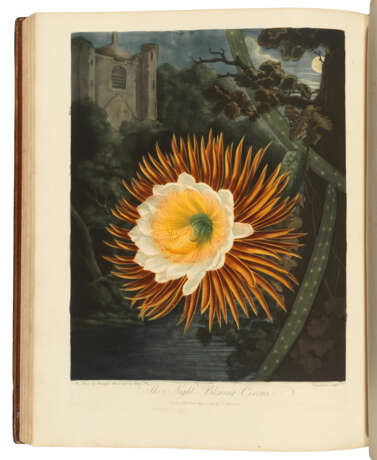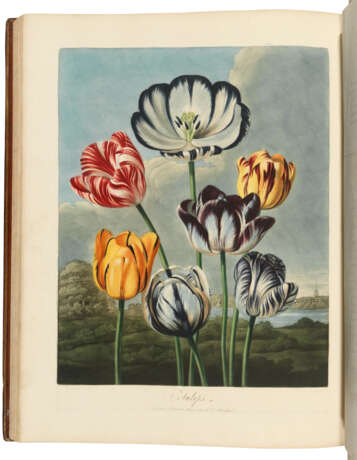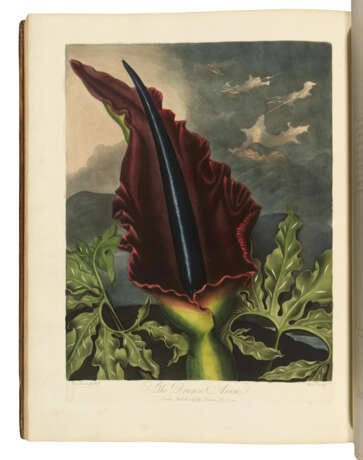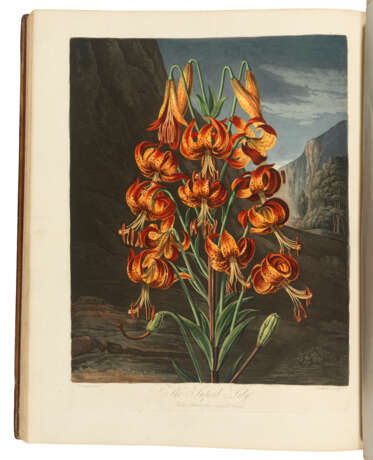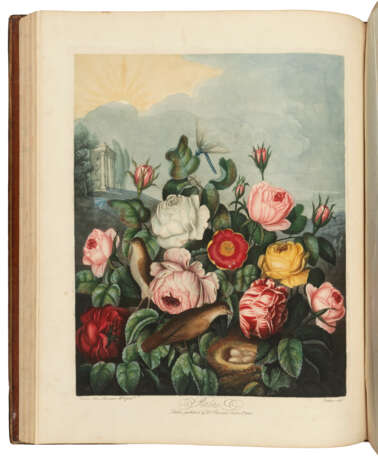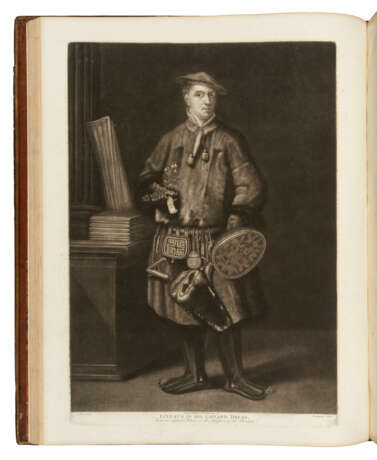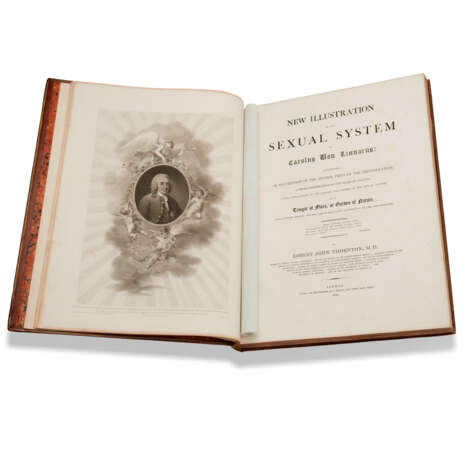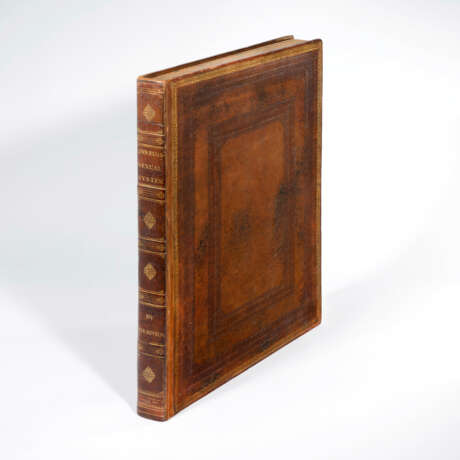ID 870698
Lot 171 | THORNTON, Robert John (1768-1837)
Valeur estimée
£ 50 000 – 80 000
New Illustration of the Sexual System of Carolus von Linnaeus . . . and the Temple of Flora, or Garden of Nature. London: T Bensley, 1807.
First edition of this magnificent work, Thornton’s Temple of Flora being one of the most original and sumptuous flower books ever produced. The plants are pictured against landscape backgrounds appropriate to the romantic spirit of the plant, creating an unusually dramatic effect. The twenty-eight celebrated plates of flowers are after paintings by Abraham Pether, Philip Reinagle, Sydenham Edwards, Peter Henderson and others, and, although a physician by training, Thornton himself provided the painting for the ‘Roses’, a particularly sumptuous plate. Ward, Earlom and Dunkarton executed the mezzotint engraving, while the aquatinting of the plates was done by Stadler and Sutherland. Although the expense incurred in the production of the work caused his ruin, Thornton created ‘the most strikingly beautiful set of flower plates ever to be printed in England, [and] one of the loveliest books in the world’ (Alan Thomas, Great Books and Book Collectors, p.144). However, its publication history was complex, leading to Sitwell & Blunt’s assertion: ‘The book is a bibliographer’s nightmare, for hardly any two copies are quite the same’ (Great Flower Books, p.42). Even the title was not used consistently; what is now universally known as The Temple of Flora is the final portion of a work which Thornton announced to the public in 1797 as a New Illustration of the Sexual System of Carolus von Linnaeus. Dedicated to Queen Charlotte, George III’s consort, the plates were very carefully directed by Thornton who was not just the publisher, but the presiding genius of the work. Influenced by contemporary aesthetic theory, no less than by the botanical discoveries of Linnaeus and their neoclassical versification by Erasmus Darwin, he selected the plants to be shown, arranged the symbolism and chose the backgrounds in a way that turned the science of botany into a drama of exotic form in visionary landscapes. Art of Botanical illustration (1994) pp.236-243 ('most eagerly sought after of all flower books'); Cleveland Collections 722; Dunthorne 301; Great Flower Books (1990) pp.41-43 and 143; Grigson & Buchanan, Thornton’s Temple of Flora (1951); Nissen BBI 1955; Stafleu and Cowan 14283.
3 parts bound in one volume, broadsheets (567 x 443mm). Part i: engraved half-title 'A British Trophy ...', engraved portrait of Thornton by F. Bartolozzi after Russell, engraved additional title, engraved portrait of Linnaeus by H. Meyer after Hollman and Bartolozzi, engraved portrait of Queen Charlotte by Bartolozzi after W. Beechy, engraved dedication, 3 engraved tables, engraved part-title 'The Prize Dissertation', engraved plates of 'The Universal Power of Love', portrait of Sir Thomas Millington, and 'Farina of Flowers', letterpress title and 28 text leaves; part ii: engraved part-title, mezzotint portrait of Linnaeus in Lapland dress by Dunkarton after Hoffman [Dunthorne's state A], 2 engraved tables, 7 text leaves; part iii: engraved title on 2 sheets, engraved table of contents, engraved dedication on 2 sheets, engraved part-title, 3 plates: 'Flora Dispensing her Favours on Earth' (aquatint and stipple engraved, hand-coloured), and 'Aesculapius, Flora, Ceres and Cupid ...' and 'Cupid Inspiring the Plants with Love' (colour-printed stipple-engravings finished by hand), 28 mezzotint and/or aquatint engraved plates printed in colours and/or coloured by hand, comprising: 'The Snowdrop' [Dunthorne state I, watermark ‘J. Whatman 1805’]; 'The Persian Cyclamen' [III]; 'Hyacinths' [II, ‘JWhatman’]; 'Roses' [II, centre rose with dark pink edged in yellow]; 'A Group of Carnations' [I]; 'A Group of Auriculas' [two only, II, ‘E&P 1806’]; 'Tulips' [II, ‘JWhatman 1806’]; 'The Queen'; 'The American Aloe'; 'The Nodding Renealmia' [II, ‘JWhatman 1806’]; 'The Night Blowing Cereus' [B, I]; 'The Oblique-Leaved Begonia' [II, ‘E&P 1086’]; 'Large Flowering Sensitive Plant' [II, ‘JWhatman 1794’]; Blue Passion Flower' [II, ‘JWhatman 1805’]; 'The Winged Passion Flower' [II, ‘J Whatman’]; 'The Quadrangular Passion Flower' [III, ‘JWhatman 1805’]; 'The White Lily' [I]; 'The Superb Lily' [B, III, ‘JWhatman 1806’]; 'The Dragon Arum' [III]; 'The Maggot-Bearing Stapelia' [I, ‘JWhatman’]; 'American Bog Plants' [II, ‘JWhatman 1806’]; 'The Pontic Rhododendron'; 'The American Cowslip' [II]; 'The Narrow Leaved Kalmia' [‘JWhatman 1805’; 'The China Limodoron'; 'The Indian Reed' [II]; 'The sacred Indian Bean' [‘J Whatman’]; 'The Blue Egyptian Water Lily'; 77 text leaves, including part-title and title (occasional faint insignificant spotting, slightly heavier to portraits at beginning, some faint finger-soiling confined to margins of a couple of plates). Contemporary russia gilt, covers panelled with deep borders of multiple fillets, palmette, floral and volute rolls, gilt turn-ins of triple fillets, spine gilt in compartments, lettered in 2 and dated at the foot, marbled endpapers and edges (rebacked retaining original spine, extremities lightly rubbed).Provenance: Col. G.R.W. Cobb (armorial bookplate).
Special notice
No VAT on hammer price or buyer's premium.
| Lieu d'origine: | Europe du Nord, Europe, Royaume-Uni |
|---|---|
| Catégorie maison de vente aux enchères: | Livres imprimés |
| Lieu d'origine: | Europe du Nord, Europe, Royaume-Uni |
|---|---|
| Catégorie maison de vente aux enchères: | Livres imprimés |
| Adresse de l'enchère |
CHRISTIE'S 8 King Street, St. James's SW1Y 6QT London Royaume-Uni | |
|---|---|---|
| Aperçu |
| |
| Téléphone | +44 (0)20 7839 9060 | |
| Commission | see on Website | |
| Conditions d'utilisation | Conditions d'utilisation |
